The natural rubber industry is passing through a period of stress, mostly due to the lower price of raw rubber and the consequent lower return to the farmer. The only way to address this situation is to increase the productivity at lower input costs.
The global warming and consequent climate change has brought in new challenges to rubber plantations. One of the important developments is the occurrence of new disease epidemics. Some of the pathogens which were considered to be of minor importance and has become causes for major epidemics in the rubber-growing regions. The last two decades, Corynespora has caused epidemics in Sri Lanka, Malaysia, Indonesia and India resulting in significant crop loss.
Fusicoccum Leaf Blight (FLB) disease, also known as Fusicoccum Leaf Fall, is the latest addition to the list of epidemic – causing pathogens. There has been an outbreak of Fusicoccum leaf fall disease during the current year in Sumatra, Indonesia. Observations made in the Sembawa Research Station, several rubber plantations and smallholders in southern and northern Sumatra indicate that all the major cultivated rubber clones are susceptible and the leaf fall could be as high as 90%. Hence, significant crop loss is expected to more than 25%.
Technical experts suggested during the International Workshop on Rubber Diseases held in Palembang, Indonesia that all IRRDB-member institutes should act on the preventive measures through information campaign to stop the spread of this disease. In this context, the Philippine Rubber Research Institute (PRRI) has conducted a joint seminar-workshop on Plant Protection for Disease Management of Rubber in collaboration with the Plant Pathology experts of the University of Southern Mindanao (USM) held in Ipil, Zamboanga Sibugay last November 13-16, 2018. The said activity aims to conduct awareness information campaign on the potential threat of Fusicoccum Leaf Blight and South American Leaf Blight (SALB) disease of rubber; and to evaluate the incidence of Fusicoccum Leaf Blight (FLB) disease in large rubber plantations of Zamboanga Sibugay. The total of sixty (60) participants were well-represented from different rubber industry stakeholders in Regions 9, 10 12 and ARMM.
During the activity proper, lecture presentations were given by the Resource Persons namely; Retired Professor Dr. Naomi G. Tangonan, Prof. Tamie C. Solpot, Ms. Jill D. Villanueva of USM and JRMSU Professor Dr. Ana Liza C. Lopez. There were healthy discussions among the participants and resource persons which tackles on the action plan on dealing/managing the potential threat of Fusicoccum Leaf Blight and other diseases of rubber. Field visit was also done in budwood nurseries and plantations of Goodyear Agrarian Reform Beneficiaries Multi-Purpose Cooperative (GARBEMCO) in the municipality of Kabasalan, Zamboanga Sibugay, were the participants were able to identify different diseases occurring in the field based on their symptoms. The participants also collected disease samples and were able to analyzed the samples in PRRI Laboratory using the microscope and other laboratory apparatuses under the supervision of Resource Persons.
At the end of the activity, positive impressions were expressed by the participants because it greatly helped them educate on the economic importance of pest and disease management of rubber; and apply the knowledge they’ve obtained towards achieving a disease-free and sustainable Philippine Rubber Industry.
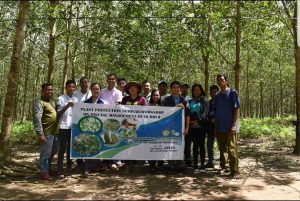
Group Picture with the Resource Persons at GARBEMCO Rubber Plantation in Brgy. Goodyear, Kabasalan, Zamboanga Sibugay
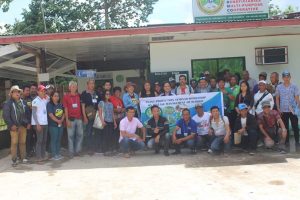
Group picture of participants with the GARBEMCO Management Staff
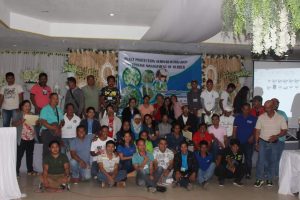
Group picture of participants at venue (Ipil, Zamboanga Sibugay)
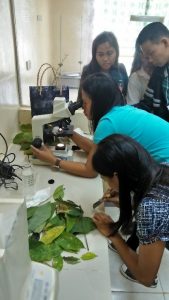
Disease diagnosis of leaf samples in PRRI laboratory
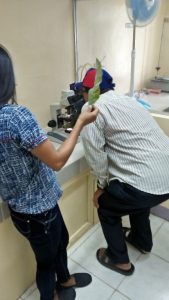
Participants actively looking on the microscope to confirm the fungal pathogen.

Microscopic View on the Conidia of a fungal pathogen Corynespora cassiicola causing Corynespora Leaf Blight of rubber
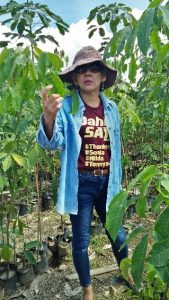
Dr. Tangonan let the participants identify the disease based on the leaf symptoms

Giving of Certificates to the participants


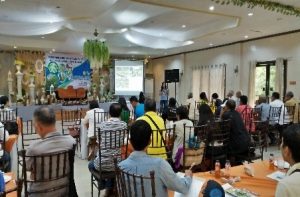

Lectures given by the Resource Persons based on their assigned topics

